Locutus D'Borg
Platinum Member
- Joined
- Dec 1, 2012
- Messages
- 5,222
In the military in the 70's Gerbers were the "best" folders you could buy at the PX/BX. I carried one for many years. Not sure where it went.
The BladeForums.com 2024 Traditional Knife is ready to order! See this thread for details:
https://www.bladeforums.com/threads/bladeforums-2024-traditional-knife.2003187/
Price is $300 $250 ea (shipped within CONUS). If you live outside the US, I will contact you after your order for extra shipping charges.
Order here: https://www.bladeforums.com/help/2024-traditional/ - Order as many as you like, we have plenty.
Wow! Never seen that. Lunchbox special made by employees at the Gerberfactory in the 1970-80 ties pehaps.An interesting example of a Mark I with serrations on the tip end of the blade (the middle knife in the attached pic). It looks like a standard production MKI blade, that was placed on the serration grinding machine that was used for the Command I (top knife), but done on both sides. Gerber introduced the MKI Tactical in 1992 and placed serrations on both sides of the blade, but closer to the handle (bottom knife). The MKI with the tip serrations has serial number 054221 on it. Something different. Enjoy.
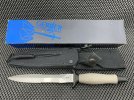
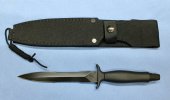
After I arrived in VN in early 1967, Dad sent me a package with a knife in it. A Swiss Army knife? Really? Oh well, Dad always was the practical sort and had my best interests in mind. But a Swiss Army Knife?No offense intended to SAK lovers.

Not the Mark I (designed by AlMar), Mark II (Designed by Army Capt. Bud Holzman). You are thinking of the Gaurdian series which was designed by Loveless. Similar knives but still different. There were several variants of these knives and they were normally sold separately, but here is a picture of one of the sets with all 3 sizes of the guardian series knives.Part of what makes these “what a knife should look like” is the fact some are Loveless designs…I think
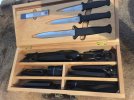



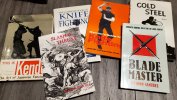
You have a GREAT Gerber collection vjb!Not the Mark I (designed by AlMar), Mark II (Designed by Army Capt. Bud Holzman). You are thinking of the Gaurdian series which was designed by Loveless. Similar knives but still different. There were several variants of these knives and they were normally sold separately, but here is a picture of one of the sets with all 3 sizes of the guardian series knives.
View attachment 2751764
Yes the using of old stock blades really makes it confusing and difficult to determin when a knife is manufactured. And of course the fake/manipulated gives that a larger universe. When its a Mark 2 the serial nr helps you. But models without serial numbers like Mark 1, Guardian and Command is harder. Details like box and sheath (if original is present) helps a bit.Zebs1, I would agree it is a Lunchbox special. The blade shape looks to me like it was initially ground too short, allowing an employee the ability to create it. I doubt it was a prototype, as it would have a standard length blade and 000000 as the serial number. As for the time frame, it is hard to say as rejected blades sometimes sat around for some time. I would think it was made after the Command (Force) series knives were introduced in 1979, since it has the same serration pattern. There were a handful of Mark II knives made in 1992 that were leftover blanks from the 1972 - 1981 timeframe. These knives have L6 tool steel blades with the slant 2 logo. A 1992 Cutlery Shopp Exclusive MKIICS (CT5) used one of these blades with serial number CS0998, and a black handle, black blade (BA5) MKII with serial number K5524S, also using one of these blades. View attachment 2750646View attachment 2750647
All of those models have serial numbers. All of the knives other than the Mark II did not change too much over the years like the Mark II did. The only reason we have a somewhat accurate record of the serial numbers / years / features of the Mark II knife is that a Gerber Production manager named Doug Hutchins made a hand written chart that later became the lists we see on John Sabol's and the Gerber Guy's, and other websites.Yes the using of old stock blades really makes it confusing and difficult to determin when a knife is manufactured. And of course the fake/manipulated gives that a larger universe. When its a Mark 2 the serial nr helps you. But models without serial numbers like Mark 1, Guardian and Command is harder. Details like box and sheath (if original is present) helps a bit.
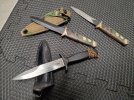
Thank you for much info on the Gerbers! Yes, of course Guradian ond Command are also serialized, I ment that its very hard to use when determin year of manufacture. Like you wrote above. I will try to post a coupe of pictures of my Guardian collection. Perhaps in a new tread.All of those models have serial numbers. All of the knives other than the Mark II did not change too much over the years like the Mark II did. The only reason we have a somewhat accurate record of the serial numbers / years / features of the Mark II knife is that a Gerber Production manager named Doug Hutchins made a hand written chart that later became the lists we see on John Sabol's and the Gerber Guy's, and other websites.
The Mark I had an OD green handle and leather sheath the first year and was made of L6 tool steel. After the first year, 1976, both were black. Later the only changes were the blade steel, the leather sheath changed to cordura and the clip went from metal to plastic. Then they made the tactical version which had serrations half way down both sides. There were also some made with black epoxy painted blades. Lastly there was an 35th Anniversary model of the Mark I made in 2011, which had basically nothing to do with the original knife and was very disappointing; it was bigger not shaped the same, had a different handle etc.. It was a decent knife, just not a Mark I in pretty much any way. All Mark I versions were serial numbered. There were apparently no records kept of what serial numbers were made in a particular year. I know that the serial numbers around 84,000 were made in about 1980, when I bought my first one.
The Command Series really did not change much except there were some orange handled models made in small quantities. There was a write in contest (I think in Blade Magazine to name this new series and the name Command was chosen. The Command one and Two were always basically a Mark I and II with the barstock not sharpened on one side except at the last couple of inches by the tip and serrated, although there were some produced without serrations. Originally they were supplied with leather sheaths and later with Cordura, but not any significant change was made in the knife.
The Guardians, (3 sizes) designed by Loveless were smaller lighter and thinner bladed than the others and they had very different handles. They were supplied individually and in a 3 knife set in a wooden box with 5 black leather sheaths. All 3 knives in the sets had the same serial numbers. At first all of these knives were brushed stainless blades with black Armorhide coated handles. Later they made each of the knives with camouflage handles and black blades. There were a few 3 knife sets sold with the camo knives in them because Gerber had some of the wood boxes left over from the original sets, but they did not have the same serial numbers and had 3 camo cordura sheaths. There was a different model of the Guardian I made later on and it was supplied in a plastic sheath with a metal boot clip.
The only knife out of all of these that continues to hold some really high values and basically much interest for me is the Mark II, due to it's association with the Vietnam War. I bought a Mark II in the mid 1970's and later around 1980 saw that early models were selling for $400 plus. I think this is what got me interested in knife collecting in the first place. Over the years I have owned hundreds of Gerber knives. Dozens upon dozens of Mark I and II series knives and quite a few of the Guardians and Commands have passed through my collection until about 10 years ago I got rid of almost all of them. Marks, Guardians, Commands, Paul's, Silver Knights, LST's, Armorhide Hunters, Folding Sportsman's, Air Frames, etc. etc. I have owned all of them. Now, out of the Command and Guardian series this is what I have.
View attachment 2752855
Wish I was there when you were selling them. Too bad these knives are not often up for sale here i Europe. When bought from USA there is alot of toll and extra feeds to get the knife here so its very costly. But I have around 30 of them now (Mark, Command, Guardian 1 and 2). I have been hooked on Gerber daggers for some years now. I bought my, first a Mark 2, in 1996 when I was in the army.All of those models have serial numbers. All of the knives other than the Mark II did not change too much over the years like the Mark II did. The only reason we have a somewhat accurate record of the serial numbers / years / features of the Mark II knife is that a Gerber Production manager named Doug Hutchins made a hand written chart that later became the lists we see on John Sabol's and the Gerber Guy's, and other websites.
The Mark I had an OD green handle and leather sheath the first year and was made of L6 tool steel. After the first year, 1976, both were black. Later the only changes were the blade steel, the leather sheath changed to cordura and the clip went from metal to plastic. Then they made the tactical version which had serrations half way down both sides. There were also some made with black epoxy painted blades. Lastly there was an 35th Anniversary model of the Mark I made in 2011, which had basically nothing to do with the original knife and was very disappointing; it was bigger not shaped the same, had a different handle etc.. It was a decent knife, just not a Mark I in pretty much any way. All Mark I versions were serial numbered. There were apparently no records kept of what serial numbers were made in a particular year. I know that the serial numbers around 84,000 were made in about 1980, when I bought my first one.
The Command Series really did not change much except there were some orange handled models made in small quantities. There was a write in contest (I think in Blade Magazine to name this new series and the name Command was chosen. The Command one and Two were always basically a Mark I and II with the barstock not sharpened on one side except at the last couple of inches by the tip and serrated, although there were some produced without serrations. Originally they were supplied with leather sheaths and later with Cordura, but not any significant change was made in the knife.
The Guardians, (3 sizes) designed by Loveless were smaller lighter and thinner bladed than the others and they had very different handles. They were supplied individually and in a 3 knife set in a wooden box with 5 black leather sheaths. All 3 knives in the sets had the same serial numbers. At first all of these knives were brushed stainless blades with black Armorhide coated handles. Later they made each of the knives with camouflage handles and black blades. There were a few 3 knife sets sold with the camo knives in them because Gerber had some of the wood boxes left over from the original sets, but they did not have the same serial numbers and had 3 camo cordura sheaths. There was a different model of the Guardian I made later on and it was supplied in a plastic sheath with a metal boot clip.
The only knife out of all of these that continues to hold some really high values and basically much interest for me is the Mark II, due to it's association with the Vietnam War. I bought a Mark II in the mid 1970's and later around 1980 saw that early models were selling for $400 plus. I think this is what got me interested in knife collecting in the first place. Over the years I have owned hundreds of Gerber knives. Dozens upon dozens of Mark I and II series knives and quite a few of the Guardians and Commands have passed through my collection until about 10 years ago I got rid of almost all of them. Marks, Guardians, Commands, Paul's, Silver Knights, LST's, Armorhide Hunters, Folding Sportsman's, Air Frames, etc. etc. I have owned all of them. Now, out of the Command and Guardian series this is what I have.
View attachment 2752855
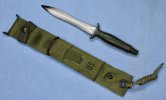
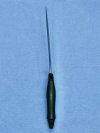
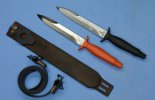
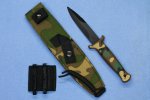
Those are all very unusual models well worth keeping. Nice finds! Probably the rarest is the guardian with a command blade. Also that leather diving sheath is very rare in that condition.Some of my rarer Gerber Survival knives. The MKII has a dark green Armorhide handle. The same dark green that the hunting series knives (Pixie - Magnum Hunter) used. The blade has the wide wasp shape with no serrations and was set in the handle at a full 5 % cant. Iy has a 1974 serial number. It came with the sheath shown, and a black dyed red / brown pointed tipped leather sheath, consistent with the serial number. The OD Green sheath has a M8 bayonet sheath lower in the nylon carrier.
The orange handled Command II, is one of the limited run of Dive knives Gerber made shortly after the Command series Survival knives were introduced. The Command series knives were originally called the Force I and Force II knives. Gerber decided to let the public come up with the name of these knives and ran an add in Soldier of Fortune Magazine. The deadline for submissions was July 1 1979, so the add was in an earlier issue. The winner was announced in the November issue of Soldier of Fortune and the winning name was the Force I and Force II. Gerber made box labels with these names and soon found out the name was not available, so Gerber changed the name to the Command I & II. It is unknown how many knives were sold with Force labeled boxes but it is under 400. The orange handled dive knives could be purchased as a set (Command I & II) or just the Command II. These knives used a slightly brighter orange than Gerber's orange handled MKII knives. These knives also have a unique epoxy used to seal the blade in the handle. It is a silver color and designed to resist salt water. Even though the blades were made with the slant 2 logo, they are stainless steel. It is unknown how many of these knives were made, but some say less than 50. These knives did not come with a Gerber Dive sheath, but mine is paired with a single stitch MKII dive sheath that was dyed with black shoe polish. The other rare knife Command II knife was special ordered without serrations. I have observed 8 of these non serrated Command II knives.
The Camo handled knife is the Gerber Brigade Command (model 5761). It sold for only one year in 1985. It has the Camo Guardian II handle and a blackened Command I blade. I have only observed 4 of these knives, but I am sure there were quite a few made as one of mine has the box and the model sticker looks like the standard model stickers. View attachment 2753223View attachment 2753224View attachment 2753225View attachment 2753226
Wow!! Real rare gems! And that camo sheth sure looks like one of a kind! Nice to see a Command II without serrations! Only read about them, never seen one.Some of my rarer Gerber Survival knives. The MKII has a dark green Armorhide handle. The same dark green that the hunting series knives (Pixie - Magnum Hunter) used. The blade has the wide wasp shape with no serrations and was set in the handle at a full 5 % cant. Iy has a 1974 serial number. It came with the sheath shown, and a black dyed red / brown pointed tipped leather sheath, consistent with the serial number. The OD Green sheath has a M8 bayonet sheath lower in the nylon carrier.
The orange handled Command II, is one of the limited run of Dive knives Gerber made shortly after the Command series Survival knives were introduced. The Command series knives were originally called the Force I and Force II knives. Gerber decided to let the public come up with the name of these knives and ran an add in Soldier of Fortune Magazine. The deadline for submissions was July 1 1979, so the add was in an earlier issue. The winner was announced in the November issue of Soldier of Fortune and the winning name was the Force I and Force II. Gerber made box labels with these names and soon found out the name was not available, so Gerber changed the name to the Command I & II. It is unknown how many knives were sold with Force labeled boxes but it is under 400. The orange handled dive knives could be purchased as a set (Command I & II) or just the Command II. These knives used a slightly brighter orange than Gerber's orange handled MKII knives. These knives also have a unique epoxy used to seal the blade in the handle. It is a silver color and designed to resist salt water. Even though the blades were made with the slant 2 logo, they are stainless steel. It is unknown how many of these knives were made, but some say less than 50. These knives did not come with a Gerber Dive sheath, but mine is paired with a single stitch MKII dive sheath that was dyed with black shoe polish. The other rare knife Command II knife was special ordered without serrations. I have observed 8 of these non serrated Command II knives.
The Camo handled knife is the Gerber Brigade Command (model 5761). It sold for only one year in 1985. It has the Camo Guardian II handle and a blackened Command I blade. I have only observed 4 of these knives, but I am sure there were quite a few made as one of mine has the box and the model sticker looks like the standard model stickers. View attachment 2753223View attachment 2753224View attachment 2753225View attachment 2753226
